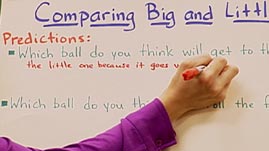Teachers' Domain - Digital Media for the Classroom and Professional Development
User: Preview

Source: WGBH Educational Foundation


Science education involves teaching both content and scientific practices to students. So while topical knowledge is central to the understanding of science, skills in the science methods are equally important. To achieve this, students can benefit from real-world activities that provide the opportunity to engage with thoughtful scientific practices.
In the lesson shown in this video, Heidi Fessenden involves her class in a hands-on experiment. She asks her students to monitor and reflect on the behavior of balls as they roll down ramps.
The lesson allows Fessenden to demonstrate principles of motion and force and help her students practice prediction and scientific observation. It also affords her the opportunity to teach scientific concepts and terminology by getting her students to use specific words to describe what they expect to see and what they actually see.
Fessenden’s unit will culminate in the students’ development of a large ramp system. In addition to having the chance to practice their prediction-making skills, the students also learn how to reflect on and gain a better understanding of prediction making in a scientific context. With such concrete activities and real-world applications, students have an easier time internalizing the scientific practices.
 Loading Standards
Loading Standards